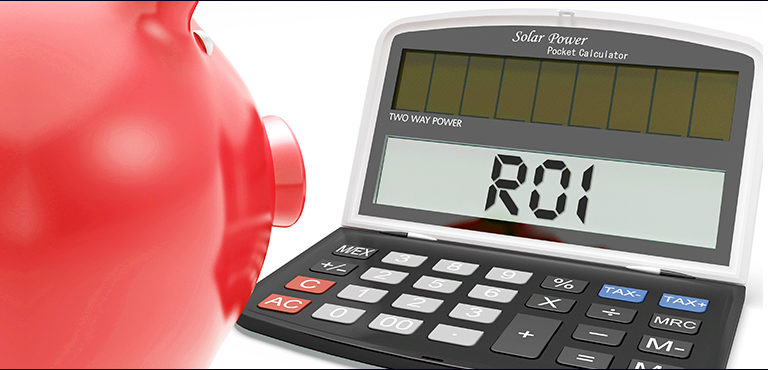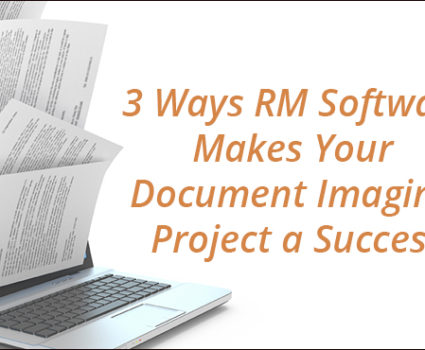
Calculating ROI of Records Management Software in 6 Steps
Many business professionals aren’t quite sure how to make the business case for records management software. They know the software will provide significant value from an operations, risk, and compliance perspective, but they find it difficult to quantify those benefits.
Some of our colleagues have gone down the path of treating RM software as a business expense. In their budget presentations, they position the software as an item of overhead that the records management department requires in order to function. However, this approach significantly under-sells the value of RM software and can lead to the project not being approved.
Fortunately, the benefits of RM software can be quantified using a straightforward method that shows a clear ROI. This helps to shift the budget conversations from “expense” to “investment.”
ROI based on efficiencies
RM software makes a direct impact on the bottom line by creating efficiencies relating to document access. It helps workers do their jobs faster and make fewer costly mistakes. There are many other benefits to RM software, but these efficiencies are the easiest to estimate, and are therefore a great starting point when building the business case.
Regardless of the method for estimating ROI, the basic objective is the same: to estimate the business return from a given investment, usually in the form of a ratio. The steps below will help you do that by exploring the many efficiencies that RM software creates in processes that involve document access.
A step-by-step approach
Step 1: Calculate employee labor costs and average time for each activity
The first calculations that need to be done are the number of full-time employees (FTE) that access physical records, and then the cost per minute for these employees. These figures will be used a few times in our calculations.
When you have your FTE number, take that number multiplied by the average hourly wage and the number of working days in the month. (We use 22 working days as the average). Take this number and divide by 60 (minutes/hour) and that gives you the per-minute labor cost across your department.
The last part of step one is to estimate how many minutes each employee spends per day on these activities:
- retrieving documents
- filing and re-filing documents
- making copies of documents
- searching for lost information
- recreating lost information.
Step 2: Calculate current monthly document access costs
“Document access costs” represent the costs in your current situation of retrieving documents, filing and re-filing copies, searching for lost information and recreating lost information. You want to take the estimated minutes for each activity (from step 1), multiply it by the per-minute labor costs (from step 1), and then add the cost of all those activities together.
Step 3: Calculate efficiency impact of software
In this step you have another assumption to make: how much time will be saved once you have implemented the RM software. In our hundreds of RM software engagements, we have seen savings between 50 and 95 percent for individual activities, but you will want to use numbers that reflect your specific situation. For the purposes of calculating ROI in this method, you will take 100 percent minus the estimated time savings to get a “reduction percentage.” For example, if the savings is 65 percent, you will use 35 percent as the reduction percentage in the next step.
Step 4: Calculate monthly and annual hard dollar savings
Now you still start to see the potential savings. Take your minutes-per-day spent on each activity (from step 1), multiply those by the reduction percentage, and then multiply that figure by the per-minute labor cost (from step 1). Total all those up to get your new monthly document access costs. Subtract that from the current monthly document access cost (from step 2) to obtain your monthly savings, and then multiply by that by 12 for the annual savings.
Step 5: Calculate the investment in records management software
For your investment costs you need to total up the RM software license fees, hardware costs, implementation fees and the ongoing maintenance over the year.
Step 6: Calculate your ROI
Take your savings in step 4, subtract the costs in step 5, and then divide that by the costs in step 5. Take that number and multiply it by 100 to obtain your ROI ratio.
With your ROI number in hand, you now have solid, defensible figure to use when making the business case or justifying an investment in RM software.
Next Steps
- Download our detailed ROI calculator, which takes you through these six steps and allows you to test different assumptions.
- We can help you explore the business case for RM software in your organization. Get in touch!
Many business professionals aren’t quite sure how to make the business case for records management software. They know the software will provide significant value from an operations, risk, and compliance perspective, but they find it difficult to quantify those benefits.
Some of our colleagues have gone down the path of treating RM software as a business expense. In their budget presentations, they position the software as an item of overhead that the records management department requires in order to function. However, this approach significantly under-sells the value of RM software and can lead to the project not being approved.
Fortunately, the benefits of RM software can be quantified using a straightforward method that shows a clear ROI. This helps to shift the budget conversations from “expense” to “investment.”
ROI based on efficiencies
RM software makes a direct impact on the bottom line by creating efficiencies relating to document access. It helps workers do their jobs faster and make fewer costly mistakes. There are many other benefits to RM software, but these efficiencies are the easiest to estimate, and are therefore a great starting point when building the business case.
Regardless of the method for estimating ROI, the basic objective is the same: to estimate the business return from a given investment, usually in the form of a ratio. The steps below will help you do that by exploring the many efficiencies that RM software creates in processes that involve document access.
A step-by-step approach
Step 1: Calculate employee labor costs and average time for each activity
The first calculations that need to be done are the number of full-time employees (FTE) that access physical records, and then the cost per minute for these employees. These figures will be used a few times in our calculations.
When you have your FTE number, take that number multiplied by the average hourly wage and the number of working days in the month. (We use 22 working days as the average). Take this number and divide by 60 (minutes/hour) and that gives you the per-minute labor cost across your department.
The last part of step one is to estimate how many minutes each employee spends per day on these activities:
- retrieving documents
- filing and re-filing documents
- making copies of documents
- searching for lost information
- recreating lost information.
Step 2: Calculate current monthly document access costs
“Document access costs” represent the costs in your current situation of retrieving documents, filing and re-filing copies, searching for lost information and recreating lost information. You want to take the estimated minutes for each activity (from step 1), multiply it by the per-minute labor costs (from step 1), and then add the cost of all those activities together.
Step 3: Calculate efficiency impact of software
In this step you have another assumption to make: how much time will be saved once you have implemented the RM software. In our hundreds of RM software engagements, we have seen savings between 50 and 95 percent for individual activities, but you will want to use numbers that reflect your specific situation. For the purposes of calculating ROI in this method, you will take 100 percent minus the estimated time savings to get a “reduction percentage.” For example, if the savings is 65 percent, you will use 35 percent as the reduction percentage in the next step.
Step 4: Calculate monthly and annual hard dollar savings
Now you still start to see the potential savings. Take your minutes-per-day spent on each activity (from step 1), multiply those by the reduction percentage, and then multiply that figure by the per-minute labor cost (from step 1). Total all those up to get your new monthly document access costs. Subtract that from the current monthly document access cost (from step 2) to obtain your monthly savings, and then multiply by that by 12 for the annual savings.
Step 5: Calculate the investment in records management software
For your investment costs you need to total up the RM software license fees, hardware costs, implementation fees and the ongoing maintenance over the year.
Step 6: Calculate your ROI
Take your savings in step 4, subtract the costs in step 5, and then divide that by the costs in step 5. Take that number and multiply it by 100 to obtain your ROI ratio.
With your ROI number in hand, you now have solid, defensible figure to use when making the business case or justifying an investment in RM software.
Next Steps
- Download our detailed ROI calculator, which takes you through these six steps and allows you to test different assumptions.
- We can help you explore the business case for RM software in your organization. Get in touch!




